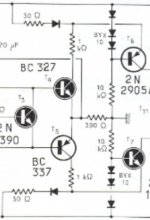Douglas Self has writen about a 'load invariant power amp' in the sense that it is a power amp whose output voltage does not change when the load changes. It is a voltage output, low (ideally zero) output impedance amplifier.
Jan
Jan
This is clearly not a transimpedance amplifier:Do you consider the Hafler Transnova to be a transimpedance amplifier? Or how about the FirstWatt ACA Mini amplifier (shown below)?
_
With the drains of Q3 and Q3 tied together, such a hard (unity) feedback is needed to avoid the output stuck on a supply rail....Mark's circuit above is a constant voltage output because while the load is driven by high impedance collectors, the global feedback is voltage feedback, so the output is constant voltage.
I went through these nested posts (dark side 2015 & good old tech 2013, both closed) to review this odd constant power / load invariant claims.Do you have this in mind?
As per agreed with elvee, the NGTT does not what it claims. I've the impression that it was an invention by accident: the current mirror was connected wrong (the bases of T6 & T7 on the cathodes instead of the anodes), resulting in a 'rounded' transfer function, resembling a square law, and claiming the constant power (square-root) function, and thus 'tube-sound' too!
Attachments
... and...What do you guys mean with load invariant power in this context? Constant voltage output, constant current output or constant power output witth changing load?
Jan
Why would someone prefer constant power? What's its use?Douglas Self has writen about a 'load invariant power amp' in the sense that it is a power amp whose output voltage does not change when the load changes. It is a voltage output, low (ideally zero) output impedance amplifier.
Jan
Constant voltage or constant current I do understand. But if the impedance of a loudspeaker varies by frequency (it is a very complex electrical-mechanical-acoustic system), it demands more or less energy or dumps energy back in the amplifier. And this dumping (output voltage rises, current flowing back into the amplifer) is what directs to a perfect voltage source, which is capable doing so.
In audio, constant power isn't useful or even desired, I agree.
I just wanted to clear up what people were meaning by their phrases, as they seemed at odds with some of the discussions.
Jan
I just wanted to clear up what people were meaning by their phrases, as they seemed at odds with some of the discussions.
Jan
